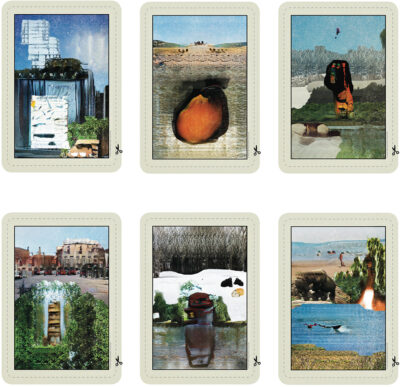
This paper introduces and contextualises Climate Futures, an experiment in which AI was repurposed as a ‘co-author’ of climate stories and a co-designer of climate-related images that facilitate reflections on present and future(s) of living with climate change. It converses with histories of writing and computation, including surrealistic ‘algorithmic writing’, recombinatory poems and ‘electronic literature’.
At the core lies a reflection about how machine learning’s associative, predictive and regenerative capacities can be employed in playful, critical and contemplative goals. Our goal is not automating writing (as in product-oriented applications of AI). Instead, as poet Charles Hartman argues, ‘the question isn’t exactly whether a poet or a computer writes the poem, but what kinds of collaboration might be interesting’ (1996, p. 5).
STS scholars critique labs as future-making sites and machine learning modelling practices and, for example, describe them also as fictions. Building on these critiques and in line with ‘critical technical practice’ (Agre, 1997), we embed our critique of ‘making the future’ in how we employ machine learning to design a tool for looking ahead and telling stories on life with climate change. This has involved engaging with climate narratives and machine learning from the critical and practical perspectives of artistic research. We trained machine learning algorithms (i.e. GPT-2 and AttnGAN) using climate fiction novels (as a dataset of cultural imaginaries of the future). We prompted them to produce new climate fiction stories and images, which we edited to create a tarot-like deck and a story-book, thus also playfully engaging with machine learning’s predictive associations.
The tarot deck is designed to facilitate conversations about climate change. How to imagine the future beyond scenarios of resilience and the dystopian? How to aid our transition into different ways of caring for the planet and each other?
Research question: How is illness storytelling shaped by digital culture?
Social media gives shape to new forms of public illness storytelling while simultaneously reinvigorating humanistic concerns about the sequestration of pain and death and their place in digital culture. One finds that memes, hashtags, and selfies are now vehicles to speak about traumatic body experiences and grief, while participatory features redraw issues of voice and agency. These contemporary illness stories are also rich in web metadata, circulate online, and are algorithmically ranked in platforms, where they reassemble at the touch of a refresh button. This project engages with this emerging phenomenon from the perspective of new media scholarship and digital methods, which are digitally native techniques for doing research with social media data. It thus asks, how is illness storytelling shaped by digital culture and vice-versa? How can empirical studies be operationalized so as to bring theories and concerns from illness narratives and the health humanities into large datasets of social media data? Can ‘methods of the medium’ such as tagging, ranking, and so-called social connections be involved and repurposed in the analysis? Which is ultimately also to ask, what can digital methods offer the cultural study of illness?


